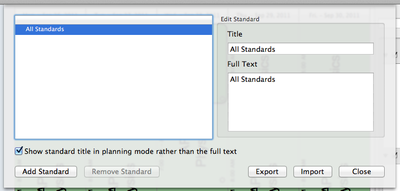Adding Standards to your Planbook File
Contents |
Overview
Before you can track standards using Planbook, you have to enter in all of the standards that you're interested in applying to lessons. There are two methods for entering standards into your Planbook data file.
- Manually enter each standard
- Import each standard from a CSV or plist file
Instructions for each method are found below. Regardless of how you want to enter your standards, the process starts with opening Planbook's standards manager. This is done by selecting the Tools-->Standards Manager menu item.
Once you have opened the Standards Manager, you'll be presented with the window shown below.
Adding Standards Manually
Adding standards manually is an easy, if tedious, process. The process begins by pressing the ![]() button in the lower left corner. This will create a standard in your Planbook. The standard will be a substandard underneath the selected standard in the table view.
button in the lower left corner. This will create a standard in your Planbook. The standard will be a substandard underneath the selected standard in the table view.
New standards are added with a default title and detail. The title and full text can easily be edited simply by clicking on the fields to the right and typing (or pasting from a webpage, word document, etc...) into the field as appropriate. Standards are updated as you type- there's no need to save or press enter to lock in your information.
After updating the title, the table view will reflect the new name immediately. As the table sorts alphabetically, the table will also resort immediately.
There is no limit to the depth of your standards- any standard you've entered can become a parent standard for other standards. The images below show the process of selecting a standard to be the parent standard, adding a new sub-standard and then revealing that standard.
Removing Standards
If you add a standard by mistake, or just want to remove one of the standards you've entered, you can easily do this by selecting the standard you want to remove and pressing the ![]() button.
button.
Please note that removing a standard will:
- Remove all sub-standards of the selected standard.
- Remove the standard (and all sub-standards) from any lesson to which they were attached
Adding Standards From a CSV File
The other method to add standards to your Planbook file is to import them from a spreadsheet program such as Apple's Numbers, Microsoft Excel or even Google Docs. Standards imported into Planbook via a CSV file must adhere to a very specific format. That format is described now.
Importing Standards (No Sub-Standards)
If you want to import a single layer of standards where there are no substandards, you must set up a two column spreadsheet. That spreadsheet must take the form:
| Standard 1 Full Text | Standard 1 Title |
| Standard 2 Full Text | Standard 2 Title |
| Standard 3 Full Text | Standard 3 Title |
Please double check your spreadsheet to ensure that:
- There are no headers in your file (don't label your columns or rows)
- There are no empty columns to the right of your standards. Please select any extra columns to the right of your data and remove them.
Once you have your spreadsheet created, please see the section on converting your spreadsheet to a CSV format.
Importing Nested Standards
The Spreadsheet format you are required to replicate becomes more complicated if you are going to import nested standards. Rather than the two column spreadsheet described above, you must create a four column spreadsheet. The format of this spreadsheet should mimic:
| Standard 1 Full Text | Standard 1 Title | ||
| Standard 1 Full Text | Standard 1 Title | Standard 1.a Full Text | Standard 1.a Title |
| Standard 1 Full Text | Standard 1 Title | Standard 1.b Full Text | Standard 1.b Title |
| Standard 2 Full Text | Standard 2 Title | ||
| Standard 2 Full Text | Standard 2 Title | Standard 2.a Full Text | Standard 2.a Title |
| Standard 2 Full Text | Standard 2 Title | Standard 2.b Full Text | Standard 2.b Title |
| Standard 2.b Full Text | Standard 2.b Title | Standard 2.b.i Full Text | Standard 2.b.i Title |
After importing the standards listed above, a series of nested standards of the format shown below will be created.
- Standard 1
- Standard 1.a
- Standard 1.b
- Standard 2
- Standard 2.a
- Standard 2.b
- Standard 2.b.i
- Standard 1
Convert your Spreadsheet to a Comma-Separated-Value Format
Your standards cannot be imported directly from the default spreadsheet formats. You must export your spreadsheet as a comma-separated-value (CSV) file. This is a file format that is easily interchanged with other applications. To save/export your file in CSV format please follow the links below depending on your spreadsheet application.
- For Apple's Numbers: http://support.apple.com/kb/HT3719 (please choose the "Create a file of your spreadsheet for applications that can open CSV files" option).
- For Microsoft Excel (2007): http://office.microsoft.com/en-us/excel-help/import-or-export-text-txt-or-csv-files-HP010099725.aspx#BMexport
- For Microsoft Excel (2003): http://office.microsoft.com/en-us/excel-help/import-or-export-text-files-HP001130599.aspx#_Toc289084172 (Be sure to choose CSV as the export format).
- For Google Docs: https://docs.google.com/support/bin/answer.py?answer=40609&hl=en. Be sure to select CSV as the Download As type. CSV will be visible in the menu if you are editing a spreadsheet.
Please Note: For CSV files exported via Microsoft Excel, you must follow an additional step before your file may be imported. Please:
- Open the Apple TextEdit application that comes free with your computer.
- Open the CSV file you exported from MS Excel.
- Choose the File-->Save As... menu item.
- Choose the UTF-8 Text encoding



